10.2: Observing Cognition
- Page ID
- 139903
Importance of Observation
The best way for caregivers to start to learn about the cognitive abilities of infants and toddlers is simply to observe them because they reveal their ever-evolving understanding of the world through their interactions with objects and people. To illustrate, look at the sequence of photos displayed in Figure \(\PageIndex{1}\) of Nora, a fifteen-month-old toddler from Nigeria. There are a few different objects Nora is playing with. There are rectangle stacking blocks of various colors and sizes and a recycled food container that has a circle cut into the lid. This sequence of six photos represents only a few seconds of her play, but in just these few seconds, we can learn a lot about her cognition. When you look at the photos, what insight do they provide about Nora’s developing understanding of how the world works?
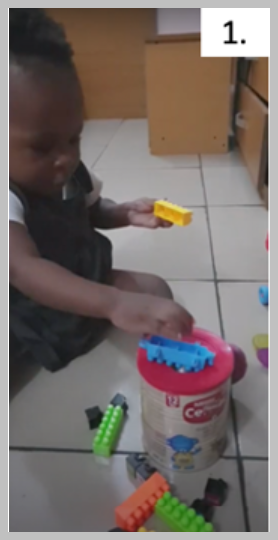
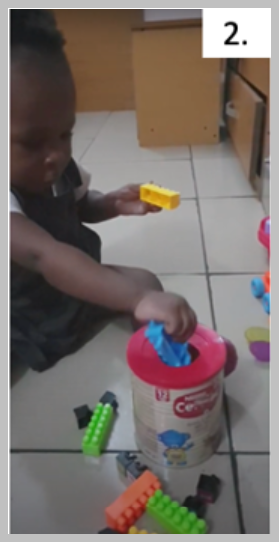
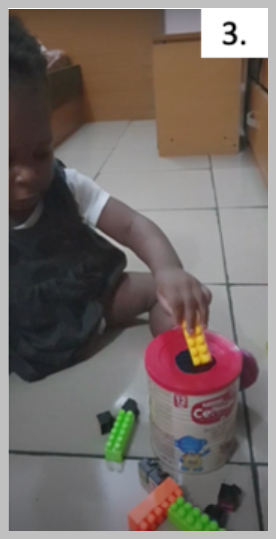
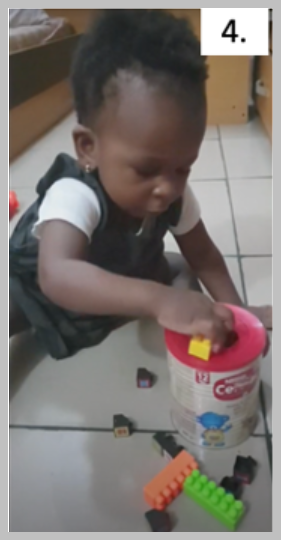
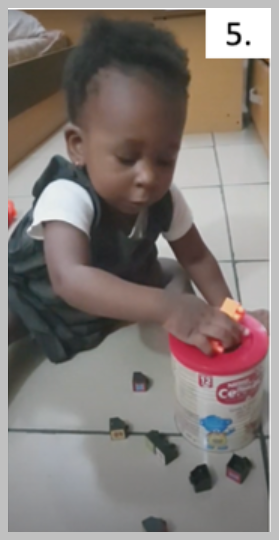
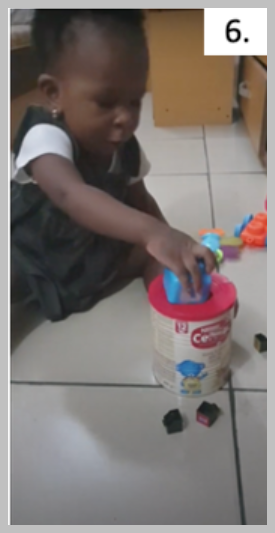
In Figure \(\PageIndex{1}\), Nora has a yellow block in her left hand and a blue block in her right hand, but is primarily focused on the blue block. In front of her is the cylinder container with a hole in its lid. and various other blocks scattered around the base of the cylinder. With the blue block in her right hand, Nora moves it toward the hole in the cylinder container and drops it onto the container lid. When laid horizontally on top of the container, the blue block is too long to fit through the round hole. In Figure \(\PageIndex{2}\), Nora lifts the blue block up again, angles one end toward the hole, guides the block part way into the hole and releases it as it falls into the container. In Figure \(\PageIndex{3}\), Nora swings her left hand, with the yellow block, toward the hole. In the same continuous movement, as her hand nears the hole entry point, she angles the end of the yellow block toward the hole and guides it directly through the hole. In Figure \(\PageIndex{4}\), Nora picks up another yellow block (from off camera) and focuses her eyes on the hole as she again angles the end of the block toward the hole and drops it into the container. In Figure \(\PageIndex{5}\), she selects an orange block but as she moves it toward the hole, she moves her eye gaze away from the hole and toward the remaining blocks on the floor. As she looks toward the blocks on the floor, her hand guiding the orange block gets stuck on the lid as the angle of the block does not fit into the hole. She then looks toward the container, adjusts the angle of the block and drops it into the hole. In Figure \(\PageIndex{6}\), Nora grabs a large toy object (from off camera) and guides it toward the hole. In the first attempt to fit it into the container, it does not fit. Nora twists her wrist to change the angle and tries again, but it does not fit.
These six photos of Nora represent only a few seconds of play, but nevertheless demonstrate important information about infant and toddler cognitive development. First, children are actively making sense of the world around them through interactions with the physical and the social world. Like young scientists, they use their knowledge to make hypotheses, then act upon them, constantly updating their knowledge based on the results. In this way, it is through the interactions with the physical and social worlds that cognition primarily grows; therefore, the quality of the physical and social environments and overall learning experiences of infants and toddlers is of utmost importance for supporting optimal cognitive development. As evidence, let’s next consider how the COVID-19 pandemic has demonstrated the significance of early learning experiences for supporting cognitive development in infants and toddlers.
[1] Images adapted from Ashley Siokwu licensed under CC by 3.0

